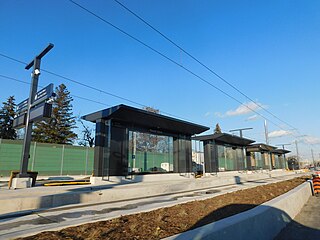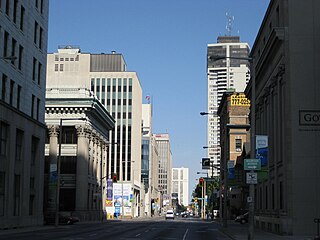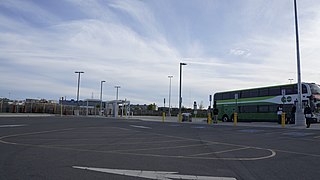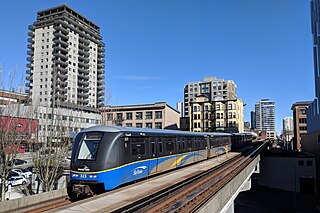
The Hamilton Street Railway (HSR) is the public transport agency for Hamilton, Ontario. The name is a legacy of the company's early period, when public transit in Hamilton was primarily served by streetcars. Although streetcars are no longer used in the city today, the HSR operates bus and paratransit services, with a ridership of 21 million passengers a year.

Lakeshore West is one of the seven train lines of the GO Transit system in the Greater Toronto Area, Ontario, Canada. It extends from Union Station in Toronto to Hamilton, along the shore of Lake Ontario. Some train trips extend past Hamilton to St. Catharines and Niagara Falls.

Milton is one of the seven train lines of the GO Transit system in the Greater Toronto Area, Ontario, Canada. It extends from Union Station in Toronto to Milton, by way of Mississauga.

Kitchener is one of the seven train lines of the GO Transit system in the Greater Toronto Area, Ontario, Canada. It extends westward from Union Station in Toronto to Kitchener, though most trains originate and terminate in Brampton in off-peak hours.

The Mississauga Transitway is a bus rapid transit (BRT) system in Mississauga, Ontario, Canada. It comprises a series of purpose-constructed bus-only roadways, as well as reserved lanes on existing city streets and portions of Highway 403, that together form a continuous 18 km (11 mi) route spanning most of the city from Winston Churchill Boulevard in the west to the junction of Highways 401 and 427 in the east on the border with Toronto. Service on the Transitway is provided by MiWay and GO Transit, with some stations providing connections to Brampton Transit and Toronto Transit Commission (TTC) bus services.

Metrolinx is a Crown agency of the Government of Ontario that manages and integrates road and public transport in the Greater Toronto and Hamilton Area (GTHA), which comprises much of Ontario's Golden Horseshoe region. Headquartered at Union Station in Toronto, the agency was created as the Greater Toronto Transportation Authority on June 22, 2006. The agency adopted its present name as a brand name in 2007 and eventually as the legal name in 2009.

Transit City was a plan for developing public transport in Toronto, Ontario, Canada. It was first proposed and announced on 16 March 2007 by Toronto mayor David Miller and Toronto Transit Commission (TTC) chair Adam Giambrone. The plan called for the construction of seven new light rail lines along the streets of seven priority transit corridors, which would have eventually been integrated with existing rapid transit, streetcar, and bus routes. Other transit improvements outlined in the plan included upgrading and extending the Scarborough RT line, implementing new bus rapid transit lines, and improving frequency and timing of 21 key bus routes. The plan integrated public transportation objectives outlined in the City of Toronto Official Plan, the TTC Ridership Growth Strategy and Miller's 2006 election platform.

Line 5 Eglinton is a light rail line that is under construction in Toronto, Ontario, Canada. Owned by Metrolinx and operated by the Toronto Transit Commission (TTC), the line will be part of the Toronto subway system as its fifth route. The first phase of the 19-kilometre (12 mi) line will include 25 stops along Eglinton Avenue, from Mount Dennis station mostly underground to Laird station, after which it will run predominantly at-grade within the street's median to Kennedy station, where it will connect underground with Line 2 Bloor–Danforth. The second phase, a 9.2-kilometre (5.7 mi) westward extension from Mount Dennis, will run mostly underground or elevated to Renforth station, with seven new stations.
The Don Mills LRT was a proposed light rail line in Toronto, Ontario, Canada. It was part of the Transit City proposal announced March 16, 2007, to be operated by the Toronto Transit Commission (TTC). It was expected to cost approximately $675 million, with construction to begin in 2012, and an expected opening in 2016. It would have been the fifth of the seven Transit City lines to be complete after the Sheppard East, Finch West, Waterfront West, and Eglinton lines. Ridership was estimated to be 21.2 million trips in 2021.
The Jane LRT is an inactive proposal for a light rail line in Toronto, Ontario, Canada. It was originally proposed in 2007, cancelled in 2010, and later revived in the 2013 "Feeling Congested?" report by the City of Toronto, where it was labelled as a "Future Transit Project". However, in April 2019, Ontario Premier Doug Ford announced the province's plans for rapid transit development and funding for the Greater Toronto Area that omitted the Jane LRT.

Line 6 Finch West, also known as the Finch West LRT, is a light rail line under construction in Toronto, Ontario, Canada, to be operated by the Toronto Transit Commission. The 10.3-kilometre (6.4 mi), 18-stop line is to extend from Finch West station on Line 1 Yonge–University to the North Campus of Humber College in Etobicoke. The line will operate in a dedicated above-ground right-of-way, much of it within Finch Avenue, segregated from street traffic. The line will use transit signal priority and standard gauge rather than the broad Toronto gauge. The line is forecast to carry about 14.6 million rides a year or 40,000 a day by 2031 and will replace the 36B Finch West bus route, which is one of the three busiest bus routes in Toronto. Line 6 was expected to open within the first half of 2024, with an estimated cost of CA$2.5 billion. For budget purposes, the TTC made the assumption that Line 6 would open no earlier than September 2024. However, the builder, Mosaic Transit Group, expects the line to open by the end of 2024.

The Hurontario LRT is a light rail line under construction in the cities of Mississauga and Brampton, Ontario, Canada. The line will run along Hurontario Street from Mississauga's Port Credit neighbourhood north to Steeles Avenue in Brampton. The line will be built and operated as a public-private partnership by Mobilinx, a consortium of private European and Japanese companies, with provincial transit agency Metrolinx retaining ownership of the line. It will be the only street railway operating in the Greater Toronto Area outside Toronto proper.

The Hamilton LRT is a planned light rail line in Hamilton, Ontario, Canada, to operate along Main Street, King Street, and Queenston Road. It is one of five planned rapid transit lines which form Hamilton's proposed BLAST network. The 14 km (8.7 mi), 17-stop route is planned to extend from McMaster University to Eastgate Square via downtown Hamilton.

The A-Line is a proposed rapid transit line running along James Street in downtown and Upper James Street on the escarpment in Hamilton, Ontario. It is part of Hamilton's proposed BLAST network, involving four other rapid transit corridors. It is identified by Metrolinx in its regional transportation plan The Big Move as a project to be completed by 2023. The route is currently served by Hamilton Street Railway's Route 20 A-Line Express bus.

Confederation GO Station is a GO bus stop and planned train station to be built by Metrolinx in East Hamilton, Ontario. The station is named for Confederation Beach Park, nearby on Lake Ontario.

Renforth, referred to during planning as Renforth Gateway, is a bus station on the border of the cities of Mississauga and Toronto, in Ontario, Canada. Located at Eglinton Avenue and Renforth Drive, it is the eastern terminus of the Mississauga Transitway and is close to the interchange between Highway 401 and Highway 427.
Dundas Street bus rapid transit is a proposed bus rapid transit (BRT) corridor proposed by Metrolinx for the western part of the Greater Toronto and Hamilton Area in Southern Ontario, Canada. It is part of the regional transportation plan The Big Move. Metrolinx currently refers to the project as Dundas bus rapid transit without the word "Street". The City of Mississauga used the brand Dundas Connects during the development phase.
A rapid transit corridor is proposed along Steeles Avenue in Toronto, Ontario, Canada, which would be operated by the Toronto Transit Commission. It has not been determined if this corridor would be a bus rapid transit or a light rail transit line. It is identified by Metrolinx in its regional transportation plan The Big Move as a project to be completed in its 25-year plan. In February 2016, City of Toronto and TTC planners recommended implementing the Steeles BRT/LRT within a 15-year horizon. At a meeting on February 20, 2020, the Metrolinx board of directors endorsed a prioritization framework for a proposed Frequent Rapid Transit Network that included a proposed BRT from Pioneer Village station to McCowan Road. The proposed 20.8 km line along Steeles Avenue had a forecasted ridership of 11,700 in 2031. The project scored 'high' with a preliminary benefit-cost ratio of over 0.90. The TTC released their 2020-2024 5-year Service Plan and 10-year Outlook, which discussed the implementation of exclusive bus lanes, stop consolidation, all-door boarding and other transit priority measures to speed up bus service on Steeles Avenue West between Pioneer Village Station and the future Steeles Station that will be constructed as part of the Yonge North Subway Extension. Currently, the implementation timeframe is to be determined following feedback on the RapidTO Eglinton East Bus Lanes and public consultation with the surrounding community.
The Big Move is a regional transportation plan (RTP) published in 2008 and consisting of 62 rapid transit projects to be implemented across the Greater Toronto and Hamilton Area (GTHA). These rapid transit projects are intended to form a seamlessly integrated regional rapid transit network, which is the first priority action in the regional transportation plan. These projects form two long-term templates with 15 and 25 year horizons. These templates outline broad projects; specific details about technology, alignment, stations and service levels for each project are subsequently determined though a cost–benefit analysis or an environmental assessment process.

Urban rail transit in Canada encompasses a broad range of rail mass transit systems, including commuter rail, rapid transit, light rail, and streetcar systems.















